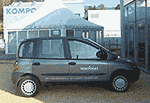by Jim Motavalli
Suppose in addition to your blue bin for recyclables, you had a green one for kitchen scraps? And suppose that those scraps were collected and mixed with yard waste, then processed in small, low-emission factories into compost and a clean fuel that could power your car? It sounds utopian, but it’s reality in Europe, where no less than 18 Kompogas plants operate. There’s even one in Japan.
Kompogas got its start in Zurich, Switzerland in the late 1980s, when inventor Walter Schmid conducted some experiments on his balcony at home. His test fermenter convinced him it would be possible to turn organic wastes (a third of the household garbage stream) into fuel and compost. The first trial plant was set up in Rmlang, Switzerland in 1991, and from there the concept has spread to Germany (which plans to ban landfill disposal of untreated solid waste by 2005) and Austria. “Kompogas is like an ox,” says Schmid. “It eats, which gives it the energy it needs to power the cart. Any surplus is used as fertilizer for the fields.”
The Kompogas plant near Zurich, Switzerland can fuel 1,200 cars and trucks like this one on reprocessed food scraps from homes and restaurants.
Though it works in close collaboration with municipalities, Kompogas is a profit-making business. The certified organic compost, made from food waste collected from homes, restaurants and supermarkets (and even the local McDonald’s), is a commercial product now appearing on gardens all over Europe. The company also sells the electricity it produces. Participating cities and towns also produce a revenue stream, by paying Kompogas a fee to take bio-waste to the five plants in the greater Zurich area.
Kompogas, a mixture of methane and carbon dioxide (CO2), can be burned in a gas motor to generate electricity, or (with the CO2 removed) used to power cars and trucks (including 1,200 in the Zurich area). It produces 80 percent less smog-forming chemicals than standard gasoline. Wastewater from the process goes into acquaculture projects and liquid fertilizer.
Kompogas engineer Ren Leisner, who runs his Volvo on the cleaner fuel, leads a tour of one of its facilities near Zurich, in Otelfingen. The plant takes in 30 tons of waste a day, which is dumped in a huge bunker that emits the pungent aroma of rotting vegetables. According to Leisner, one ton of waste produces the equivalent of 18 gallons of biofuel. With just 220 pounds of scraps, a car can travel 62 miles. The local McDonald’s runs its trucks on Kompogas, and European speed merchants Rinspeed use it in their race vehicles, producing “the cleanest sports car in the world.”
From the bunker the organic matter moves along a conveyer (where foreign material is removed) to a fermenter, where it breaks down under anaerobic conditions. It takes 15 to 20 days at 130 degrees Fahrenheit for the material to be processed. If the world’s organic waste was converted in a similar way, an impressive 10 percent of the world’s vehicle fleet could run on the resulting clean fuel. So why not try it in the U.S.?
++++
FROM E Magazine, a SustainableBusiness.com Content Partner
Europe's KompoGas

Published on: March 4, 2004
(Visited 30 times, 6 visits today)